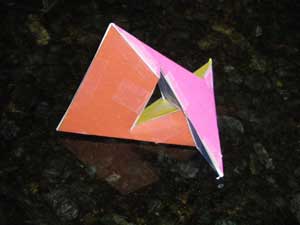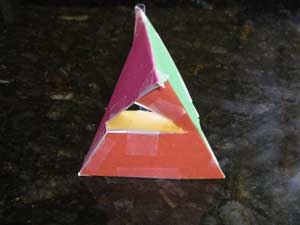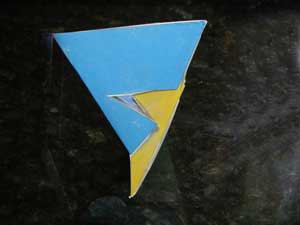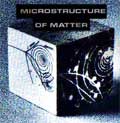The Szillasi Polyhedron
We had never heard of a Szillasi polyhedron until a few days ago. We were browsing some of Ivars Peterson's old MathTrek columns at the MAA site and came across his article on A Polyhedron With A Hole. Naturally, we were intrigued. The polyhedron in question has seven faces, each with six sides, and it is highly irregular. The faces aren't even convex. The polyhedron also has a hole in it, which isn't all that odd, but it does make it topologically the same as a doughnut. Doughnuts, despite the best work at Duncan Donuts and the like, can be colored with no more than seven colors, no matter how you arrange the blobs of icing and sprinkles. This doughnut, with seven faces, and seven colors is nicely minimal, and it's neat to look at.
We were soon over at David King's House of Hexagons site to learn more, and to find a model of this oddity to print out and fold up. As it turns out, they were first discovered in 1977 by Lajos Szillasi, a Hungarian mathematician, so they are pretty recent. No one has been finding these things painted on cave walls, carved in ancient ivory or in the notebooks of Leonardo da Vinci. They are just a bit over 30 years old, just a baby by mathematical standards.
Dr. King has a rather nice live rotation of the figure, and you could be satisfied by that. For us Kalebergs, there is nothing quite like holding an actual object, albeit fragile and ill formed, in our hands. Dr. King had a cut out and paste version of the polyhedron, but it was strictly black and white. Of course, he's a real mathematician. He doesn't actually have to color things to think about coloring things. We Kalebergs are made of lesser stuff, so we took his artwork and colored it, and then colored it some more. We rewrote his instructions a bit, though I doubt that ours are any clearer. Finally, we asked him politely, and he said it was just fine if we posted our version for the handful, perhaps even dozens, of people who will ever view this web page.
Some Photographs of our Model
As we mentioned earlier, there is nothing like a physical model. So, here are some pictures of our actual physical model of Lajos Szillasi's excellent polyhedron. While these pictures lack the immediacy and interactiveness of that clever Javascript rotation program, they might be a bit of a help if you decide to cobble one of these together on your own.
Print, Cut, Tape
Here is our luridly, but tastefully, colored version of the Szillasi polyhedron. Your best bet, if you want to print this out is to use your browser's view image or save image feature, and then print the resulting image. Not only have we colored the polyhedron, we've even give you clues about which color links up with which edge of each face. There are four pieces. We recommend cutting out A first and then the others. You might want to keep this image up on your browser to help you figure out what goes where. We can't guarantee anything. If you live in some weird seven dimensional manifold, or if you lack the necessary brane space, you might find it impossible to do the necessary folds. Still, it's only a sheet of paper and some inkjet ink. Give it a try.










